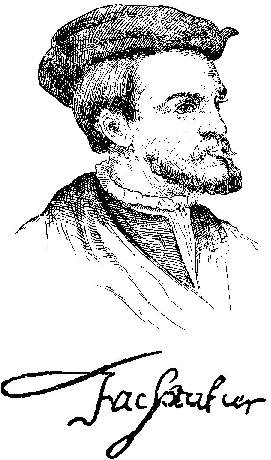
CARTIER, Jacques, explorer,
born in St. Malo, France, in December, 1494 ; died about 1557.
He had led a seafaring life, and made fishing voyages to the grand banks of Labrador, when he entered, about 1534, upon his voyage of discovery. Steering for Newfoundland, he passed through the straits of Belle Isle into the gulf of Chaleurs, and planted a cross at
Gaspe, decorated with the arms of France, and bearing the inscription, " Vive le Roi de France !" The native indians, who
surmised no good from its erection, he deceived by saying that it "was only set up to be as a light and leader which ways to enter into the port." He also caused two young Indians to be kidnapped, whom he carried away with him to France, after ascending the St. Lawrence, past the shores of Anticosti, not doubting that he had discovered the road to Cathay.
In the year ensuing, 19 May, 1535, he began his second voyage with three small vessels, and, steering westward along the coast of Labrador, entered a small bay opposite the island of Anticosti, which he called the bay of St. Lawrence.
He proceeded cautiously up the river, past the Saguenay and Cape Tourmente, and anchored off a wooded and
vineclad island ; he called it, on account of the rich clusters of grapes, the island of Bacchus (the island of Orleans), and, after friendly converse with the
Indians, notably with Donnacona, their chief, descried the majestic site of the modern Quebec, then called Stadacone, went in a boat up the St. Croix river (now the St. Charles), and, understanding that many days' journey up the river Hochelaga (for by that name the Indians called the St. Lawrence) there was a large town of the same name, he resolved to go thither. The Indians were averse to his going, and tried to frighten him by sending three of their number, disguised as devils, with blackened faces and "horns on their heads more than a yard long." But Cartier was not dissuaded from his purpose, and on 2 Oct., 1535, his vessels lay in the stream off
Hochelaga, the modern Montreal.
The Indians there received the French with demonstrations of great joy, and on the following day introduced them into their rudely fortified city, containing fifty log houses about 150 feet in length and from 12 to 15 feet in width; they set before Cartier their paralyzed chief, that he should touch and heal him; a crowd of afflicted people came for the same purpose, "as if a god had come down to cure them." He read, in default of other or better medicine, a portion of St. John's gospel over them, made the sign of the cross, and, after a prayer, concluded with reading to them, either in Latin or French (whereof they did not understand a word), the story of the passion, and distributed among them knives, hatchets, beads, pewter rings, etc. A blast of trumpets terminated the visit.
Delighted with the country. Cartier returned to Stadacone, and in a fort, which he had built on the St. Charles, passed a terrible winter ; and, after treacherously possessing himself of the person of Donnacona and his chiefs, returned, with marvellous stories of his discoveries, to St. Malo, 16 July, 1536. The said chiefs received baptism, but died in the land of their captivity. Cartier, in the capacity of
captain-general, joined the expedition of Roberval, who was made
lieutenant-governor and viceroy of the numerous American territories, and preceded the latter, leaving St. Malo, 23 May, 1541.
On his return to Stadacone, Cartier announced the death of Donnacona, and spread the false report that the other chiefs had married in France and lived in great affluence,
at Cape Rouge he and his companions landed, gathered imaginary diamonds in the shape of quartz, and carried off some yellow glittering mineral, which they fancied to be gold. They built two forts ; Cartier explored the rapids above
Hochelaga, and, owing to the discontent occasioned by the non-arrival of Roberval, or from other causes not yet ascertained, soon after his return to the forts, appears to have abandoned the prosecution of the enterprise, and reached the harbor of St. John simultaneously with the arrival of Roberval in June, 1542.
The viceroy was indignant, and ordered him to return; but Cartier succeeded, under cover of night, in abandoning the expedition, and, instead of proceeding to the St. Lawrence, bade adieu to New France on his way to the old, steered eastward, and returned to St. Malo. Of his subsequent fortunes very little is known. His merits as a discoverer were rewarded by a patent of nobility; he owned a house at St. Malo, and the seigniorial mansion of Limoilou. It is said that Cartier, at the king's request, set out to fetch
Roberval home, and we may infer that he did so, if it is true that he lived for many years at St. Malo, where Thevet, the cosmographer, the personal friend of Cartier and Roberval, spent five months with him. He also says that Roberval died at Paris. Cartier called the St. Lawrence the "River of Hochelaga," or "the great river of Canada," limits the designation of "Canada" to a stretch of country from the Isle des Coudres to a point above Quebec, and says that the Indians called the country above Quebec "Hochelaga," and that below the city "Saguenay." "Canada," according to him, is an Indian word, and signifies a town. "Ils appellent une ville, Canada," and in the Indian origin of the word he is sustained by other early French authorities, one of whom, however, renders it "terre," that is, "land," while another calls it an Indian proper name of unknown meaning.
Edited Appleton's American Biography
Copyright©
2000 by VirtualologyTM



























































